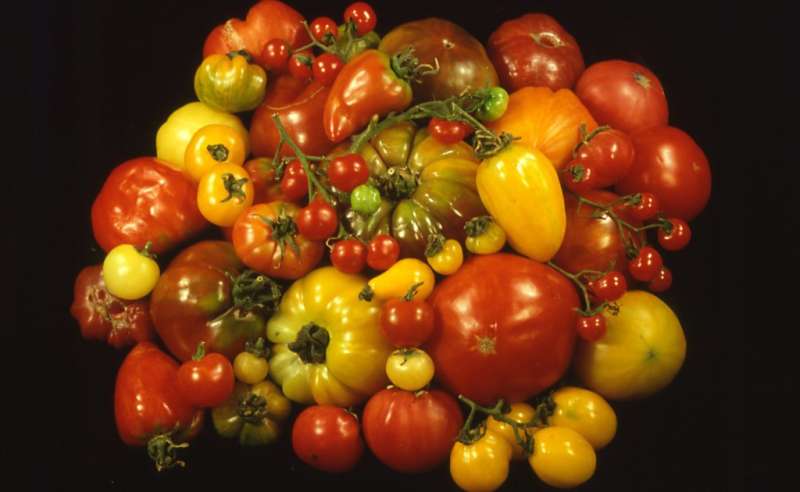Forgotten crops making meals taste better

Local farmers and researchers are foraging through forgotten crops to recover long-lost flavours.
Lessons from traditional farming are revealing how agricultural diversity can make food production healthier, tastier and more environmentally sustainable.
While there are over a million varieties of fruits and vegetables catalogued in European seed banks, only a handful of them ever find their way to supermarket shelves.
According to Professor Antonio Granell at the Institute for Plant Molecular and Cellular Biology in Valencia, Spain, modern crops made the cut because they boost the yields of large fields with minimal hassle. The man-made hybrids on our plates can typically grow throughout the year, adapt to different soils, and withstand diseases, pesticides and long periods of refrigeration.
In spite of these perks, Prof. Granell said that crops in the shops typically lack one key quality: they don't taste very good.
'The market currently rewards farmers for quantity, not quality,' said Prof. Granell. 'Fruits and vegetables can be delicious, but most fine-looking varieties sold today taste like water.'
Traditional genomes
In an attempt to recover lost flavours, Prof. Granell is combing through tomato DNA in search of genes that affect taste.
Pinpointing slight variations among the genome's 900 million base pairs is like searching for a needle in a haystack. To speed up the process, the EU-funded TRADITOM project has widened the search by comparing a broader range of tomato varieties.
Although there are precious few varieties of tomato growing on Europe's fields today, over the past 40 years researchers have stored the seeds of local predecessors for safekeeping. By tapping into these repositories, TRADITOM partners have gathered DNA from over 1 500 forgotten breeds and started replanting many in the laboratory.
By drawing on the diversity of their chemical properties, Prof. Granell hopes to cross-breed resilient, nutritious and flavour-filled tomatoes.
Some traits combine well. According to Prof. Granell, much of the antioxidants and branches of amino acids that make tomatoes healthy also taste good. The big challenge is to grow them at a bargain price.
When farmed over industrial scales, traditional crops typically yield less food, are more vulnerable to disease and parasites, and spoil sooner than modern varieties. Any losses inevitably inflate the price of produce that does reach the market.
'The problem is that genes that offer resilience often compromise on taste,' said Prof. Granell. He expects that selective breeding can play down some of these drawbacks but that bringing down prices further will ultimately require changes in how the crops are grown and sold.
While the one-size-fits-all approach of industrial farming is ill-suited to diversifying farming techniques or distribution channels, other agricultural experts have already warmed to the idea.
Agroecology
'For 15 years, we have been working with local farmers on what we call agroecological techniques,' said Dr Véronique Chable at the French National Institute for Agricultural Research in Rennes. 'One thing that we have learnt is that nature needs diversity to remain resilient.'
Dr Chable works with rural associations across Europe to help breed, grow and market organic crops. She and her colleagues advise farmers on statistical methods to check the efficiency of traditional farming practices and how best to cross new populations. The seeds and farming techniques that come out of this research remain natural and environmentally responsible.
'Crops sustain vast populations of pollinating insects and life-giving microbes in the soil,' said Dr Chable. 'The homogeneity of factory farming threatens these species. It is not just a matter of taste, we have to reconnect with food diversity if we are to protect the ecosystems that feed us.'
To explore new ways of reintroducing diversity in the food chain, the EU-funded DIVERSIFOOD project has brought together farmers, bakers, scientists, consumers and local governments across the EU. Together they are helping agroecological networks share seeds, food processing machinery, expertise and new ideas on how to bring their produce to the market.
'Some farmers have branched out into bakery,' said Dr Chable. 'By selling crops as traditional bread instead of organic grain, they can market the superior quality of their product while competing with the price of a supermarket baguette.'
Quality labels, farmer markets and on-site product transformation are some examples of how DIVERSIFOOD partners are broadening the appeal of traditional food. In France alone, the number of farmers involved in organic networks has grown over the past decade from a few dozen to several thousand. Demand for their produce continues to outstrip supply.
According to Dr Chable, interest in food diversity is emerging globally. She is involved with agroecological networks across Europe, has met with peers as distant as North Korea, and points out that most of the crops consumed around the world are still grown from traditional seeds today.
'Traditional agriculture requires manpower, reorganised food markets and informed consumers,' said Dr Chable. 'But it is sustainable, it is healthy and it also tastes better.'
Provided by Horizon: The EU Research & Innovation Magazine





















